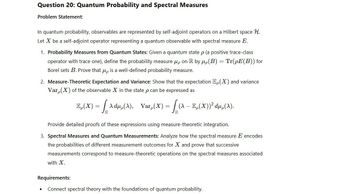
Algebra & Trigonometry with Analytic Geometry
13th Edition
ISBN: 9781133382119
Author: Swokowski
Publisher: Cengage
expand_more
expand_more
format_list_bulleted
Question

Transcribed Image Text:Question 20: Quantum Probability and Spectral Measures
Problem Statement:
In quantum probability, observables are represented by self-adjoint operators on a Hilbert space H.
Let X be a self-adjoint operator representing a quantum observable with spectral measure E.
1. Probability Measures from Quantum States: Given a quantum state p (a positive trace-class
operator with trace one), define the probability measure μp on R by μ(B) = Tr(pE(B)) for
Borel sets B. Prove that up is a well-defined probability measure.
2. Measure-Theoretic Expectation and Variance: Show that the expectation E(X) and variance
Var, (X) of the observable X in the state p can be expressed as
E(X) = [Adµ(A), Var(x) = [ {A – E‚(X))² dµ‚(A).
Provide detailed proofs of these expressions using measure-theoretic integration.
3. Spectral Measures and Quantum Measurements: Analyze how the spectral measure E encodes
the probabilities of different measurement outcomes for X and prove that successive
measurements correspond to measure-theoretic operations on the spectral measures associated
with X.
Requirements:
Connect spectral theory with the foundations of quantum probability.
Expert Solution
This question has been solved!
Explore an expertly crafted, step-by-step solution for a thorough understanding of key concepts.
Step by stepSolved in 2 steps with 6 images

Knowledge Booster
Similar questions
- Suppose that the probability of observing |0⟩ in the state |ϕ1⟩ is 1/4 and the probability ofobserving |1⟩ in the qubit |ϕ2⟩ is 1/3.arrow_forwardSuppose that the probability of observing |0⟩ in the state |ϕ1⟩ is 1/4 and the probability ofobserving |1⟩ in the qubit |ϕ2⟩ is 1/3.(a) Find the probability of observing |01⟩ in the state |ϕ1ϕ2⟩.arrow_forwardDetermine whether th e given consump-tion matrix is productive.arrow_forward
- Q. 8.(a) Let {e} be an orthonormal set in a Hilbert space H, then Σ|(x,e₁) | ² ≤||x||² for each vector x in H.arrow_forwardDetermine discrete numeric function corresponding to the following generating function: A(Z)=1/1-Z³arrow_forward7. What is the z-transform of the signal x(n) = -anu(-n-1)? A. B. C. D. 1 1-az -;ROC |z||a| ROC |z|<|al|arrow_forward
- What exactly is the Modulus operator?arrow_forwardLet o denote the Euler phi-function. If F is defined by F(n) = Σφ(d?) d|n Is F multiplicative? Explain your answer. Larrow_forwardLet I be the linear operator on R³ defined by L( Find the matrix A representing L with respect to S= Find the matrix B representing L with respect to T= s={ T= ) Find an invertible matrix P such that B=P-¹AP. Turkçesic L, R² üzerinde L( 12 311-12. 1] tabanına göre L nin temsil matrisi A yı bulunuz. O O 5 -1₁ B = P¹AP sağlayan tersi olan P matrisini bulunuz. A= A = 1-15, -3 A L 11 -3 ← 4-11171 A- 9 %], 9 tabanına göre L nin temsil matrisi B yi bulunuz. B = 11 3 ,B 1 18 3- [1/ 18 -7 -12 = +1([2] B 1/2 9/2 1/2 -[24]. B = [ 0 = 1/2 1/2 -3/2] 18 - A.B {/₂2]· 7 1/2 1/2 21 2² 2], P = [¹/² ¹/²] -3/2) 0 1 9/2 371-7₂2 şeklinde tanımlanan bir lineer dönüşüm olsun: 2 [1²7], P = [2²3] P = - [29 [23] P=[ A] -3 ³], P = [1, 2] 2arrow_forward
- In Example 3 of Section 3.1, find all elements a of S(A) such that a2=e. From Example 3 of section 3.1: A=1,2,3 and S(A) is a set of bijective functions defined on A.arrow_forwardCalculus Define T:P4P3 by T(p)=p. What is the kernel of T?arrow_forward6. In Example 3 of section 3.1, find elements and of such that but . From Example 3 of section 3.1: and is a set of bijective functions defined on .arrow_forward
arrow_back_ios
SEE MORE QUESTIONS
arrow_forward_ios
Recommended textbooks for you
- Algebra & Trigonometry with Analytic GeometryAlgebraISBN:9781133382119Author:SwokowskiPublisher:Cengage
 Elementary Linear Algebra (MindTap Course List)AlgebraISBN:9781305658004Author:Ron LarsonPublisher:Cengage Learning
Elementary Linear Algebra (MindTap Course List)AlgebraISBN:9781305658004Author:Ron LarsonPublisher:Cengage Learning Elements Of Modern AlgebraAlgebraISBN:9781285463230Author:Gilbert, Linda, JimmiePublisher:Cengage Learning,
Elements Of Modern AlgebraAlgebraISBN:9781285463230Author:Gilbert, Linda, JimmiePublisher:Cengage Learning,  Linear Algebra: A Modern IntroductionAlgebraISBN:9781285463247Author:David PoolePublisher:Cengage Learning
Linear Algebra: A Modern IntroductionAlgebraISBN:9781285463247Author:David PoolePublisher:Cengage Learning

Algebra & Trigonometry with Analytic Geometry
Algebra
ISBN:9781133382119
Author:Swokowski
Publisher:Cengage

Elementary Linear Algebra (MindTap Course List)
Algebra
ISBN:9781305658004
Author:Ron Larson
Publisher:Cengage Learning

Elements Of Modern Algebra
Algebra
ISBN:9781285463230
Author:Gilbert, Linda, Jimmie
Publisher:Cengage Learning,

Linear Algebra: A Modern Introduction
Algebra
ISBN:9781285463247
Author:David Poole
Publisher:Cengage Learning